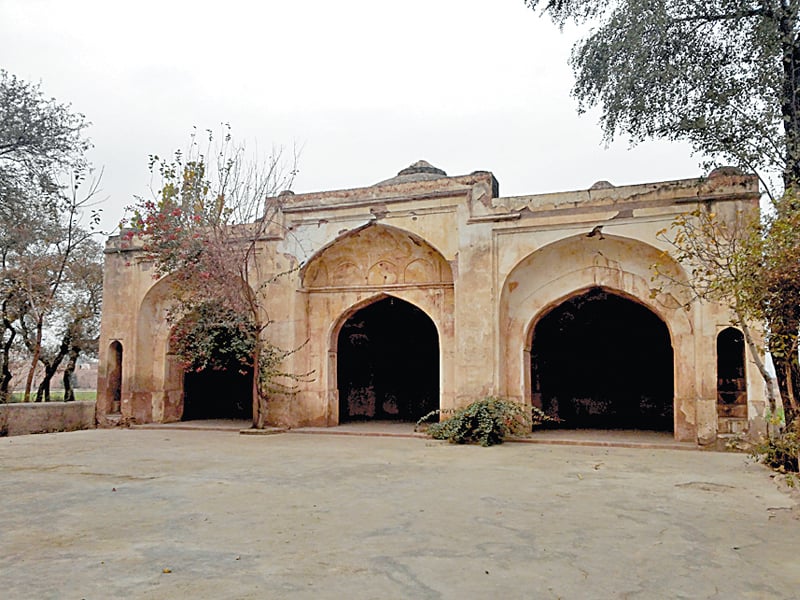
Steeped in rich Mughal history, the tall dome of the centuries-old shrine in Palosai village still stands out.
Situated outside The University of Agriculture, some 15 kilometres from the walled city of Peshawar, the Mughal-era monument also houses a mosque. A slab on one of the outer walls states the red-brick building to be a shrine of renowned saint Shaikh Imaduddin, who died in 1650.

The inscription on the building states the construction was initiated in 1652 by Imaduddin’s disciples and was completed in 1658. PHOTO: HIDAYAT KHAN/EXPRESS
Imaduddin was a famous saint of the region and is still revered by locals, which is why the village housing the shrine is known as Palosai Peeran, or the saint’s village.
The inscription further states that work on the structure was initiated in 1652 and completed in 1658 by the saint’s disciples, Shaikh Abdul Razaq and Shaikh Abdul Haq. Another person’s name written on the slab is indecipherable.
The square-shaped building is around 2.5 metres high, with the saint buried in the centre of the building and some chambers on the southern side of the shrine.
Ihsan H Nadeem, in his book Peshawar: heritage, history and monuments writes: “Although there is no specific date stating when the mosque was constructed, its architecture suggests it was constructed during Mughal Emperor Shah Jehan’s period”.
On the south-east side is a simple yet attractive mosque with a prayer chamber, a mihrab (niche identifying the direction of the Ka’aba) and a courtyard. On the inside, the mosque is decorated with floral and geometrical patterns in different colors.

Noted historian Professor Ahmad Hasan Dani, in his book Peshawar: Historic City of the Frontier, said the monument is situated on Machini road and use to serve as a thoroughfare between Peshawar and Khyber during the Mughal era.
Even though the mausoleum and mosque are protected under the Antiquities Act, 1975, there are no on-ground preservation measures. The steel board erected by the provincial archeological department to inform visitors of its historical importance is itself in shambles. The mosque is still in a relatively better condition as it is used for prayers, but the mausoleum is in an extremely decrepit state.
“Regardless of its dilapidated state, people still come here to pay their respects,” said Subhanullah, an elder of the area, adding the government has appointed workers to look after the site but they only maintain the greenery around the mausoleum.
“Years have passed and the monument is yet to be repainted and repaired properly. If this gross negligence continues, the building will come crashing down and become a part of history books as has happened with other historical sites of the city.”
Published in The Express Tribune, December 26th, 2013.
COMMENTS (3)
Comments are moderated and generally will be posted if they are on-topic and not abusive.
For more information, please see our Comments FAQ
1728297472-0/Fousey-(1)1728297472-0-405x300.webp)

1730806672-0/diddy-(37)1730806672-0-165x106.webp)
1731748155-0/BeFunky-collage-(8)1731748155-0-165x106.webp)







People require more hospitals, schools, shelters than mosques and masjids. The government as a welfare state should provide basic amenities to the people than useless, worthless praying halls.
@Salil - Hope you are joking dear. I feel the subcontinent should open up its doors for both sides to freely interact for religious / study / tourist purposes. This will set right many of our problems including crumbling heritage which we share .
There are many mosques more than people in Pakistan. Nothing to lose if one or two mosques are dilapidated.